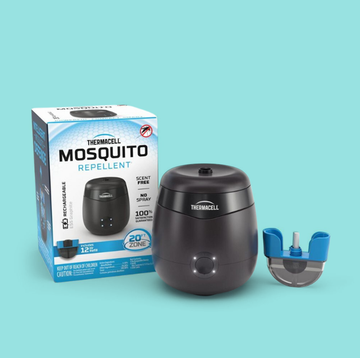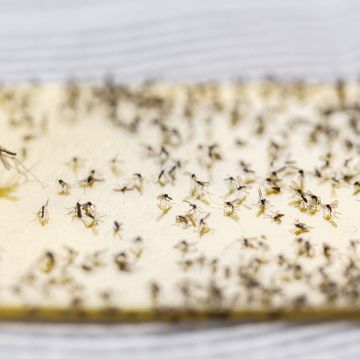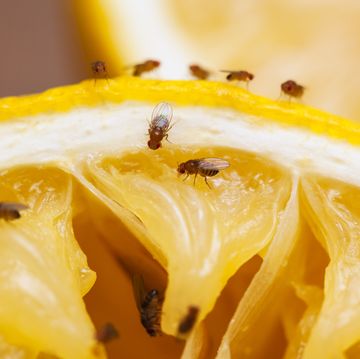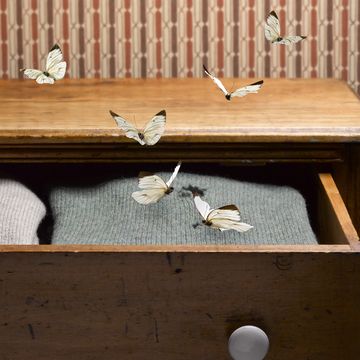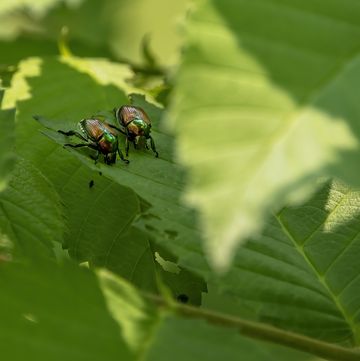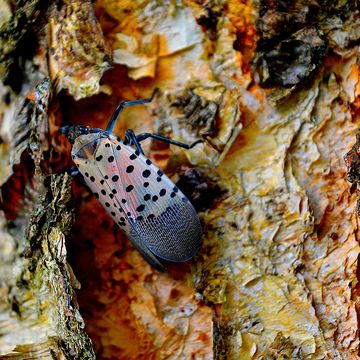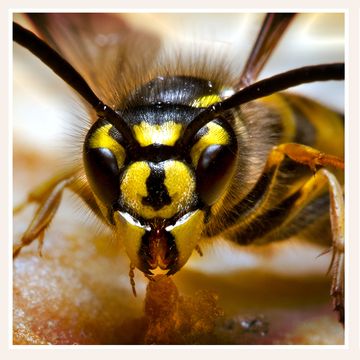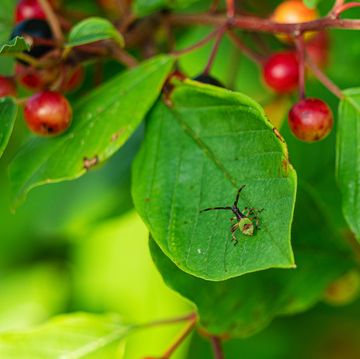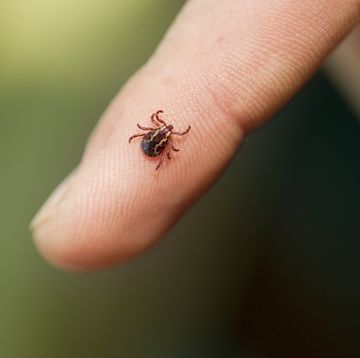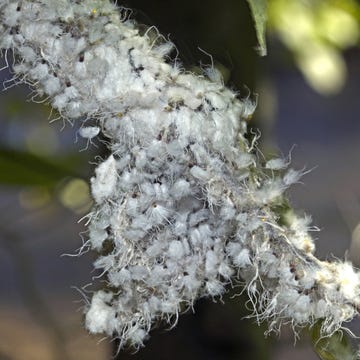Warmer weather means more time spent outdoors. The downside? The summer season's arrival might also mean an abundance of one specific type of pest in and around your home — wasps.
These aggressive insects come out in the spring, buzzing over sweet treats, fruity cocktails and overfilled trash cans. Their overbearing presence in your house or backyard may have you searching desperately for a solution. That's why we're here to tell you how to get rid of wasps — whether you need to kill wasps instantly or prefer to get rid of the insects naturally.
We've also included descriptions of the most common types of wasps, because not all are dangerous — in fact, many species will only sting when threatened, so it may be fine to co-exist. And if you've located a large colony on the side of your house, under the deck or in a tree out back, keep reading for a safe way to get rid of wasp nests.
Common Types of Wasps
There are thousands of different wasp species that inhabit the U.S. — upwards of 4,000, according to Dr. Jim Fredericks, Ph.D., chief entomologist for the National Pest Management Association (NPMA). From yellow jackets to paper wasps, here are the types you're mostly to spot inside your house and around the property.
Mud Daubers
Mud daubers, defined by their long, slender bodies and black wings, are less aggressive than other species. They're typically brown or black in color, though some may have yellow stripes. They usually build their nests on buildings, but they rarely sting.
Paper Wasps
Paper wasps, recognized for their long legs and abdomen, are either black or brown and often have yellow or brown striping. Their paper-like nests are shaped like umbrellas and can be found tucked within tree branches, porch ceilings, door frames and windows.
Yellowjackets
With their bright yellow bodies and black markings, yellowjackets are one of the most common and aggressive wasp types. They're incredibly territorial and have a habit of repeatedly stinging when threatened.
Bald-Faced Hornets
Another aggressive type, the bald-faced hornets are large with thick, round bodies. The social insects are mostly black with white or ivory markings. Their round, papery nests are commonly found in trees and bushes, so be wary in your garden.
Cuckoo Wasps
Unique for their shiny green color and small size, cuckoo wasps are solitary insects and mostly harmless.
European Hornets
European hornets, aggressive only when they feel threatened, are brown with yellow stripes. They typically hide nests in barns, attics and even abandoned bee hives, with the average nest containing 200 to 400 workers.
How to Get Rid of Wasps
Set up Wasp Traps
Wasp traps lure the insects inside a container with a tempting treat like sugar water, then prevent their escape. You can make a DIY fly or wasp trap in about five minutes by sawing the top off a two-liter bottle and inverting it inside the bottom. Hang your trap on tree branches where the wasps like to congregate.
If the DIY route isn't for you, purchase a trap online, like a solar-paneled trap on Amazon. According to Chris Walker, The Wasp Expert, a trap likely won't completely solve a wasp problem because all of the insects may not enter it. When using a trap, your best bet is to locate it nearest to the wasp nest entrance.
Create a Solution With Vinegar
According to a study published in the Journal of Pest Management Science, acetic acid, the ingredient found in vinegar, mixed with water is an effective solution that lures wasps and other pests. Simply mix apple cider vinegar, sugar and water together in a bowl. Stir thoroughly and leave the solution near the nest so wasps will drown.
Use Essential Oils
Certain scents — like peppermint, glove geranium and lemongrass — are proven to repel wasps. Mix several drops of each oil with water and dish soap in a spray bottle and coat areas on the outside of your home where wasps like to build nests: under eaves, porch roofs and other ledges and crevices. You can even spray the solution on plants, as the mixture isn't harmful to them.
Research published in the Journal of Pest Management Science found that a combination of clove, geranium and lemongrass essential oil successfully repelled wasps, and peppermint oil alone may also be effective.
Mix Soap and Water
You can tackle small hanging nests with a mixture of two tablespoons of dish soap in a spray bottle filled with water. "The soap clogs their breathing pores (called spiracles) and they die almost instantly," Walker says. Be careful: Since you'll need to get close to spray the nests, your risk of being stuck will be higher.
Try a Wasp Spray
Rather than making your own solution, purchase a wasp spray (like Hot Shot) that's designed to kill on contact and has a jet spray that reaches up to 27 feet — making it less likely to get stuck as you spray.
This is a great product for outdoor use and for tackling a nest directly, but it's not safe for indoor use and isn't ideal for targeting individual insects. It's always best to spray nests at sunset when wasps are less active, direct the spray toward the entrance first. The following day, check for activity in the nest. If you still see movement, spray again.
How to Prevent Wasps
Patch up Cracks
If you want to keep wasps from invading your house, preventative measures are key, says Walker. He recommends sealing up tiny cracks — like those around the edges of siding and where power lines enter the house — and patching up holes in window screens. The best time to do this is in late fall after most worker wasps have died off or in early spring before nests become active.
"Use a combination of caulk or expandable foam sealant, like Great Stuff, to plug cracks and holes," suggests Dan DiClerico, director of the Home Improvement & Outdoor Lab at the Good Housekeeping Institute. However, if you do discover wasps inside your house, don't try to seal the nest inside the wall, thinking they’ll just die off. "They’ll find their way out through vents or even chew through drywall," says Walker.
Keep Trash Covered
Wasp problems are usually worse in backyards that have lots of food sources in the form of exposed garbage, recycling bins and composting food matter. Make sure to tightly seal the lids to your garbage bins. "Bins with a secure locking lid are ideal, but a pair of bungee cords should also do the trick," says DiClerico. You might also consider composting indoors if you find your compost pile close to the garden is causing problems.
Don't Let Food Sit Out
Wasps love "As invaders of backyard barbecues, stinging insects are attracted to sweets and proteins, and thus people," says Dr. Fredericks. He suggests "pouring canned drinks into cups when enjoying a cold beverage outdoors. Wasps are known to climb into cans and sting when an unsuspecting person takes a sip." Generally, keep sugary beverages and all food out of reach whenever possible.
Clean up the Garden and Around Fruiting Trees
Wasps are attracted to the sweet juices found in different fruits, from apples and peaches to berries. If you're growing fruits and veggies in the backyard, make sure anything that falls from trees or bushes is promptly picked up.
How to Get Rid of Wasp Nests
A professional pest controller is recommended when removing wasp nests. However, if you want to remove the nest on your own, follow these steps:
- Spray a store-bought wasp killer, like Hot Spot, onto the nest at least 24 hours before removal. Wear gloves and white attire, as black and other dark tones are perceived as threats.
- Check the next day for signs of activity in the nest. If you still see movement, spray again and wait to make sure the wasps are dead.
- Cover the nest with a garbage bag.
- Gently pull the nest from where it's hidden and seal the bag once inside.
- Throw the bag away and seal it with a tight-fitting lid.
Mariah Thomas (she/her) is an assistant editor for Good Housekeeping, where she covers home and lifestyle content. Mariah has more than four years of editorial experience, having written for TLC, Apartment Therapy, Women's Health and Avocado Magazine. She received her master's degree in journalism at the Craig Newmark Graduate School of Journalism and published her first book, Heart and Soul: Poems of Thoughts and Emotions, in 2019. She's also the founder of RTF Community, a platform for creatives of color to connect, learn and showcase their work.
Alyssa Gautieri (she/her) is the associate lifestyle editor for Good Housekeeping, where she covers all things home and interior design. Prior to joining GH in 2022, she wrote for publications including ELLE Decor, Chairish, BobVila.com, Unique Homes Magazine and LODGING Magazine, in addition to crafting product copy for home brands like BrylaneHome and VIGO Industries.









